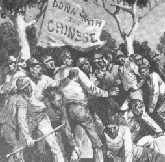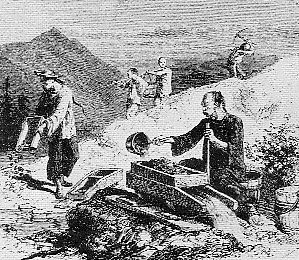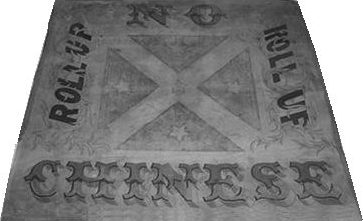 |
|
The Lambing Flat riots were a series of violent anti-Chinese demonstrations that took place in the Burrangong region, on the goldfields at Spring Creek, Stoney Creek, Back Creek, Wombat, Blackguard Gully, Tipperary Gully, and especially Lambing Flat (now Young), N.S.W., in 1860-1861. When gold was discovered in the area in mid-1860 large numbers of diggers flocked to the field. The Chinese were also attracted to the area; as one contemporary account observed, "At last John Chinaman put in his appearance..." [in those days the Chinese were often referred to as "John" or "John Chinaman"], "...As soon as John got a footing on Lambing Flat he communicated with his countrymen, and they came up from all quarters and commenced their digging operations."(1)
Delays in officially proclaiming the goldfield encouraged lawlessness (once a goldfield was "proclaimed" the government would then set up administrative and police personnel in that area, but until then there would be little or no "law and order"). On Tuesday 13 November 1860 a "roll-up" of diggers drove about 500 Chinese off the diggings, destroying their tents. On 27 November the area was proclaimed, but the inexperienced commissioner appointed was powerless to maintain order. Therefore, due to the lack of adequate police protection on the goldfields, the miners set up a vigilante committee and took the law into their own hands by destroying a number of sly-grog shanties (which were known resorts of thieves) on the weekend of the 8th and 9th of December. On the Sunday a force of diggers then drove about 50 Chinese from the diggings.(2)
Subsequently other attacks were made on the Chinese; and during one of the outbreaks the miners went to the Gold Commissioner's camp and threatened to burn down the police barracks. In January 1861 the miners determined to obtain a pledge from Europeans on the field to prevent the Chinese from working there. At about this time a few police were sent to the diggings, but their number was too small to deal with the trouble. Angered by the presence, and practices, of the Chinese, and alarmed at the prospect of being swamped by them, the miners arranged a meeting to be held on 27 January 1861 "for the purpose of taking into consideration whether Burrangong is an European gold-field or a Chinese territory". Following that meeting, the diggers marched - despite the attempts of the police to halt them - into the Chinese quarter and drove out several thousand Chinese. By the end of the day all of the Orientals had been cleared out from the Burrangong goldfields.(3)

|
However, the Chinese soon drifted back to the diggings. The anger of the European miners grew, and seethed towards boiling-point. Police reinforcements arrived. Early in February, the miners petitioned the government, asking that the Burrangong goldfields be proclaimed a European diggings. Following this, the Gold Commissioner promised that no Chinese would be allowed onto the diggings until the petition had been answered; however, the Government - yielding to other pressures - instructed the Commissioner to allow the Chinese in for the time being, "until the matters were investigated more fully" (it was considered that such discrimination against the Chinese in Australia would be contrary to Britain's treaty with China). On Sunday 17 February a crowd of European miners gathered at Blackguard Gully, near the Chinese quarter, insults were exchanged, a fight developed, more Whites rushed to the "Roll up", and the Celestials were put to flight. The police arrived and arrested fifteen miners. As news spread of the arrests, thousands of diggers gathered, and they then swept through the diggings, expelling the Chinamen.(4)
Following this, Charles Stewart - leader of the anti-Chinese movement - initiated the creation of a Miners' Protective League "to champion the digger's rights and enforce their code of justice". The League printed, and widely distributed, a list of their objectives, which included expulsion of the Chinese, repeal of gold duties, parliamentary representation, unlocking of public lands, "promulgation of the Word of God throughout the mining districts of the colony", and protection of native industry. The League then held mass meetings at various camps on the diggings.(5)
There were several reasons why the Chinese were disliked by the European mining population:
1) The miners viewed them as an alien people, both in a cultural sense (with their strange customs, language, music, dress, food, pigtails, religion, joss houses, etc.), as well as in a racial sense (they were an alien race that had entered Australia in such large numbers that some areas had already become Asianised, and the White population were facing the possibility that Australia would be overrun by these people by the sheer weight of their numbers). The miners did not want large numbers of Chinese to be allowed into the country.(6)
2) It was believed that the Chinese were practitioners of various evil and degrading ways: gambling, homosexuality, poor standards of hygiene, "corrupting European girls", and "pagan and idolatrous habits"; also opium smoking was a widespread habit among the Chinese (a practice which many Europeans found abhorrent), and the Chinese drug houses (known as opium dens) were shunned as places of evil.(7)
3) It was a common Chinese practice to take over the diggings left behind by the Europeans, indeed, it was seldom that the Chinese would begin digging upon new ground. But it was the usual custom of many European miners that they'd dig for a main strike of gold, then go off to an area were gold had been newly found, set up new diggings until that strike had run out, and then return to their original site (which they had established, and dug deep, with much hard work and sweat) to dig out the final traces of gold - sometimes only to find that a horde of Chinamen had taken it over. White diggers argued that "it was only sensible to work over the most productive ground first, then come back to that which had been passed over".(8)
4) The miners were also angered by the wasteful use of water (which was in short supply) by the Chinese. Wastage of water was a cardinal sin on an alluvial mining field which could not carry on its work without adequate supplies of that vital necessity. Indeed, it was at about this time there were minor disturbances elsewhere over this question, and on some fields Chinese were arrested for refusing to carry out the gold commissioner's instructions concerning water rights.(9)
5) As the Chinese had entered the goldfields in such large numbers, it was seen that these alien hordes were taking over the gold producing areas that otherwise would have been available to the European mining population. This meant that the economic prospects of the European miners were lessened.(10)
It is considered that the 1st and 5th reasons given here were the most important in the Europeans' dislike for the Chinese.
The Chinese question had assumed such a serious character that early in March 1861 the Premier of New South Wales, Charles Cowper, decided to visit the field in person, in an attempt to placate the miners and to directly control the military units that had been despatched to the area (although he left Sydney two days after arrival of the forces at Burrangong). Cowper addressed a public meeting of about 200 people, where strong opposition was expressed against the presence of the Chinese. Cowper told the meeting that it was the intention of the Government to protect the Chinese if they returned to the diggings, but he assured the miners that their grievances would be considered when the rioting ceased. A detachment of troops, that had been ordered to the field on 23 February, finally arrived on about 12th March 1861 (this force included 130 men from the 12th Infantry Regiment, two cannons and 44 men from the Royal Artillery, and 21 mounted police); and thus many Chinese subsequently returned to the locality. The presence of the military force prevented fresh disturbances, and the field was quiet until it departed on 24th May.(11)

The banner of the White miners: "No Chinese, Roll Up, Roll Up" |
The troops departed, against the advice of the Chief Gold Commissioner, two days after a violent clash at Native Dog Creek goldfield. This incident, coupled with rumours of hordes of Chinese approaching Burrangong, led to a "roll-up" on Sunday, 30th June, when a crowd of about 1000 men, many armed with bludgeons, pick-handles, and whips, assembled at Tipperary Gully, displayed a "No Chinese" standard, formed themselves into a rough kind of order, and, led by a band, took to the road for the main diggings at Lambing Flat; there they attacked every Chinese on whom they could lay their hands. The chief object of the mob was to drive out the Chinese, and cut off their long pigtails (which at that time most Chinese wore). The mob had now grown to between 2000 and 3000 and the Chinese were driven off. Even women and children joined in the "roll up". The tents left behind were burnt and in many cases goods were destroyed. Following this, the miners headed for the Chinese camped at Back Creek, who fled when told of the approaching mob; however, miners on horseback overtook the fleeing Orientals, many of whom were then beaten up. Thus, the Chinese were driven from their encampments at Lambing Flat and Back Creek.(12)
The leaders of the movement were Charles Stewart, William Spicer, and Donald Cameron (the Government was to later offer a reward of £100 each for the three of them) of whom it was later said that "it is only fair to state that the movement which was inaugurated by them had assumed such gigantic proportions that they were unable to wield the weapon they themselves had forged. They were not parties to, nor did they sanction the cruelties that were committed against the unfortunate Celestials...".(13)

Troopers attack the White miners |
As a direct result of the troubles at Lambing Flat, which had emphasised the population's objections to the threat of the "Chinese menace", the Government of New South Wales passed the Chinese Immigration Act, which became law on 27th November 1861; this severely restricted the numbers of Chinese permitted to enter the colony. The Goldfields Act, which limited the Chinese to certain areas (in theory), was made law on the same day.(18)
The miners, as well as the general population, objected to the Chinese presence in Australia (including objections to the cultural and mining habits of the Chinese); but the Australian colonial governments, despite these widespread and deeply held objections, continued to allow an influx of huge numbers of Asian immigrants. Their petitions and pleas for an end to the Asiatic invasion being ignored, the European miners found themselves with few options to oppose the Oriental menace. The Lambing Flat Rebellion was a result of the failure of the Government to listen to the White population, which was strongly opposed to the possibility of the Asianisation of Australia. It was this rebellion which provided a strong impetus for the development of laws against further Chinese immigration; and therefore Lambing Flat has been described as "the shrine of White Australia".(19)